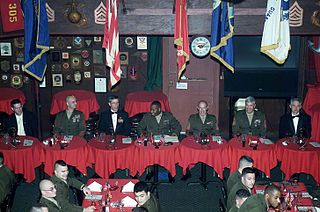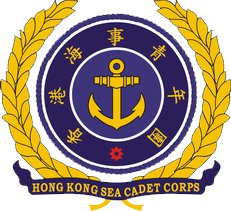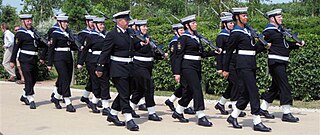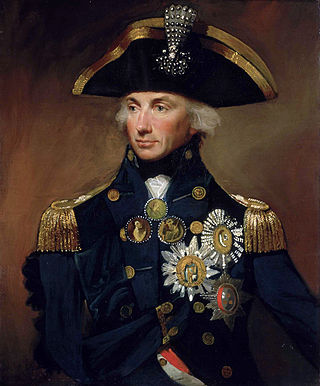
The Battle of Trafalgar was a naval engagement between the British Royal Navy and the combined fleets of the French and Spanish Navies during the War of the Third Coalition of the Napoleonic Wars (1803–1815).

Vice-Admiral Sir Thomas Masterman Hardy, 1st Baronet, GCB was a British Royal Navy officer. He took part in the Battle of Cape St. Vincent in February 1797, the Battle of the Nile in August 1798 and the Battle of Copenhagen in April 1801 during the French Revolutionary Wars. He served as flag captain to Admiral Lord Nelson, and commanded HMS Victory at the Battle of Trafalgar in October 1805 during the Napoleonic Wars. Nelson was shot as he paced the decks with Hardy, and as he lay dying, Nelson's famous remark of "Kiss me, Hardy" was directed at him. Hardy went on to become First Naval Lord in November 1830 and in that capacity refused to become a Member of Parliament and encouraged the introduction of steam warships.

"England expects that every man will do his duty" was a signal sent by Vice-Admiral of the Royal Navy Horatio Nelson, 1st Viscount Nelson from his flagship HMS Victory as the Battle of Trafalgar was about to commence on 21 October 1805.

Vice Admiral Cuthbert Collingwood, 1st Baron Collingwood was an admiral of the Royal Navy, notable as a partner with Lord Nelson in several of the British victories of the Napoleonic Wars, and frequently as Nelson's successor in commands.

Captain John Quilliam RN; MHK was a Royal Navy officer who served as first lieutenant on HMS Victory at the Battle of Trafalgar. He was a farmer's son who was impressed into the Royal Navy in 1791.

HMS Agamemnon was a 64-gun third-rate ship of the line of the British Royal Navy. She saw service in the American Revolutionary War, French Revolutionary and Napoleonic Wars, and fought in many of the major naval battles of those conflicts. She is remembered as being Nelson's favourite ship, and was named after the mythical ancient Greek king Agamemnon, being the first ship of the Royal Navy to bear the name.

Sir William Beatty was an Irish surgeon who served in the Royal Navy. Born in Derry, Ireland, he joined as a surgeon's mate in 1791 at the age of 18. He is best known as the ship's surgeon aboard HMS Victory during the Battle of Trafalgar, at which he witnessed the death of Admiral Horatio Nelson, and for writing an account of that battle – Authentic Narrative of the Death of Lord Nelson.

Dining in is a formal military ceremony for members of a company or other unit, which includes a dinner, drinking, and other events to foster camaraderie and esprit de corps.
Colin Saunders White was a British military historian, director of the Royal Naval Museum from 2006 until his death and one of Britain's leading experts on Admiral Horatio Nelson and the Battle of Trafalgar.

The Trafalgar Cemetery is a cemetery in the British Overseas Territory of Gibraltar. Formerly known as the Southport Ditch Cemetery, it occupies a small area of land just to the south of the city walls, in what had been a defensive ditch during the period of Spanish rule of Gibraltar. Although it is named for the Battle of Trafalgar of 21 October 1805, only two victims of the battle are buried there. The remainder of the interments are mostly of those killed in other sea battles or casualties of the yellow fever epidemics that swept Gibraltar between 1804 and 1814. In addition, tombstones were transferred to the Trafalgar Cemetery from St. Jago's Cemetery and Alameda Gardens.

There are many customs and traditions associated with the Royal Navy of the United Kingdom. Many of these traditions have carried on to other Commonwealth navies, such as Canada, India, Australia and New Zealand. These include formal customs such as separate crests associated with ships, ensigns and fleet reviews. There are also several less formal customs and traditions, including Naval slang commonly referred to as Jack Speak and the traditional games of Uckers and Euchre.

Horatio Nelson, 1st Viscount Nelson, 1st Duke of Bronté, was a British flag officer in the Royal Navy famous for his participation in the Napoleonic Wars, most notably in the Battle of Trafalgar, during which he was killed. He was responsible for several famous victories that helped to secure British control of the seas, both securing Britain from French invasion and frustrating Napoleon's imperial ambitions. After his death during his defeat of the combined French and Spanish fleets at Trafalgar, there was a public outpouring of grief. Nelson was accorded a state funeral and was buried in St Paul's Cathedral.

Hong Kong Sea Cadet Corps is a youth organization based in Hong Kong and formed in 1968 by former Royal Naval Reserve officers by the creation of Hong Kong Law

HMS Forward is a Royal Naval Reserve unit located in Birmingham, England, close to St. Andrews football stadium. It has a crew of nearly 100 naval and marine reservists, in addition to a handful of full-time staff. The Birmingham University Royal Naval Unit, the Defence Technical Undergraduate Scheme 'Taurus Squadron' and a detachment of the Royal Marine Reserves Merseyside are also located on the site. The ship is particularly unusual in that it is situated 80 miles from the sea.

Horatio Nelson, 1st Viscount Nelson, 1st Duke of Bronté, was one of the leading British flag officers in the Royal Navy of the French Revolutionary and Napoleonic Wars, responsible for several important victories over the French and Spanish navies during a time of crisis for the country. He was widely lauded for his success, and praised for his skill and daring. After his death during the Battle of Trafalgar, he became revered as a British hero, and his fame reached new heights. Large numbers of monuments and memorials have been created in his honour, and he has continued to influence British culture and society.
The 1805 Club was founded in 1990 to accomplish three objectives. To assist in the preservation of monuments and memorials relating to Vice- Admiral Lord Horatio Nelson and seafarers of the Georgian era. To promote research into the Royal Navy of the Georgian period, and especially of Vice Admiral Lord Nelson. To organize cultural and historical events.

Captain George Miller Bligh (1780–1834) was an officer of the Royal Navy, who saw service during the French Revolutionary and Napoleonic Wars, eventually rising to the rank of Captain. He was present aboard HMS Victory at the Battle of Trafalgar, and was badly wounded during the action. He was taken below and was present in the cockpit at the death of Vice-Admiral Horatio Nelson.

The Trafalgar campaign was a long and complicated series of fleet manoeuvres carried out by the combined French and Spanish fleets; and the opposing moves of the Royal Navy during much of 1805. These were the culmination of French plans to force a passage through the English Channel, and so achieve a successful invasion of the United Kingdom. The plans were extremely complicated and proved to be impractical. Much of the detail was due to the personal intervention of Napoleon, who as a soldier rather than a sailor failed to consider the effects of weather, difficulties in communication, and the Royal Navy. Despite limited successes in achieving some elements of the plan the French commanders were unable to follow the main objective through to execution. The campaign, which took place over thousands of miles of ocean, was marked by several naval engagements, most significantly at the Battle of Trafalgar on 21 October, where the combined fleet was decisively defeated, and from which the campaign takes its name. A final mopping up action at the Battle of Cape Ortegal on 4 November completed the destruction of the combined fleet, and secured the supremacy of the Royal Navy at sea.

Vice-Admiral Horatio Nelson, 1st Viscount Nelson, 1st Duke of Bronte was a British flag officer in the Royal Navy. His inspirational leadership, grasp of strategy, and unconventional tactics brought about a number of decisive British naval victories during the French Revolutionary and Napoleonic Wars. He is widely regarded as one of the greatest naval commanders in history.

HMS Victory is a 104-gun first-rate ship of the line of the Royal Navy, ordered in 1758, laid down in 1759 and launched in 1765. She is best known for her role as Lord Nelson's flagship at the Battle of Trafalgar on 21 October 1805.



















